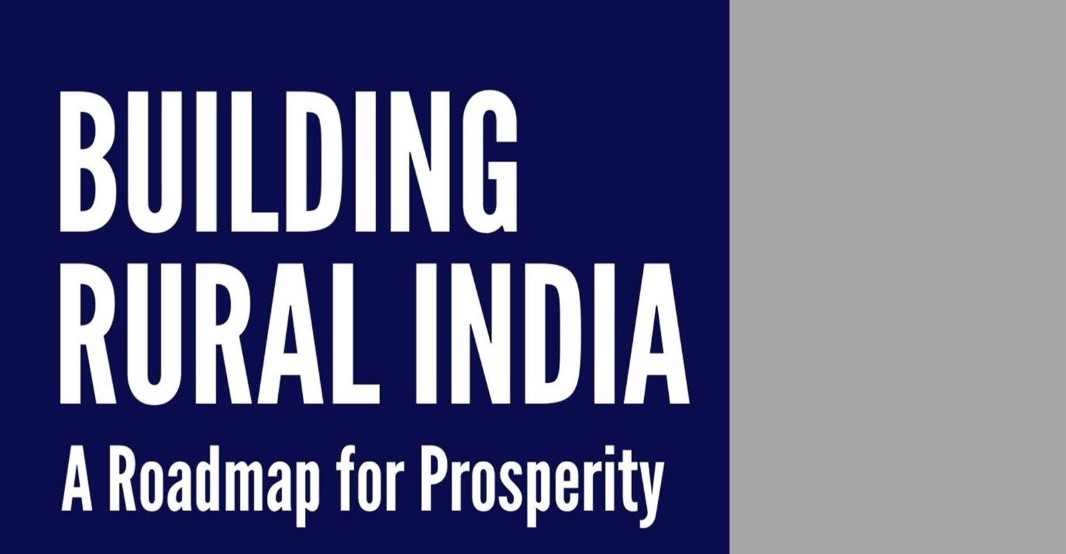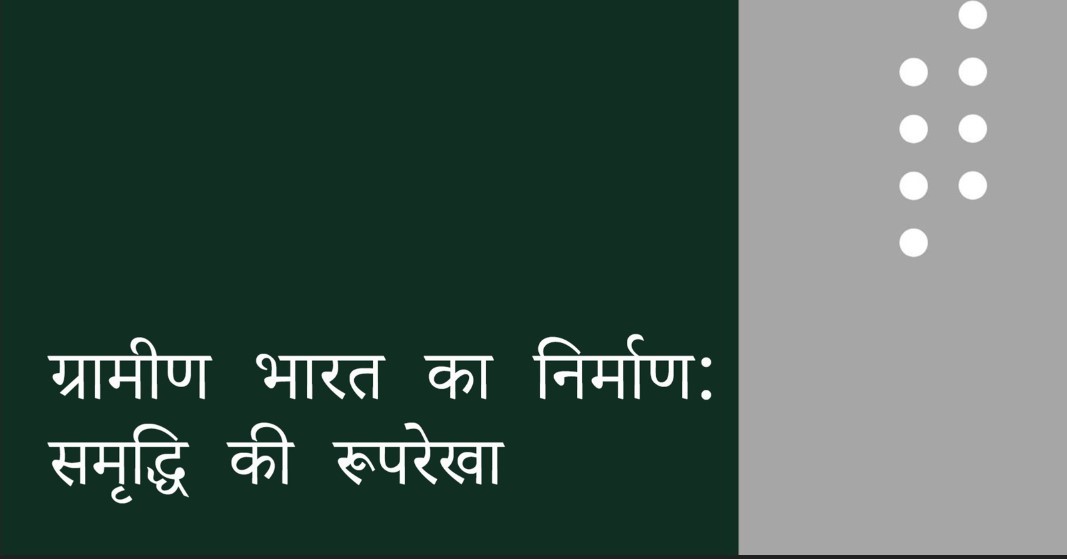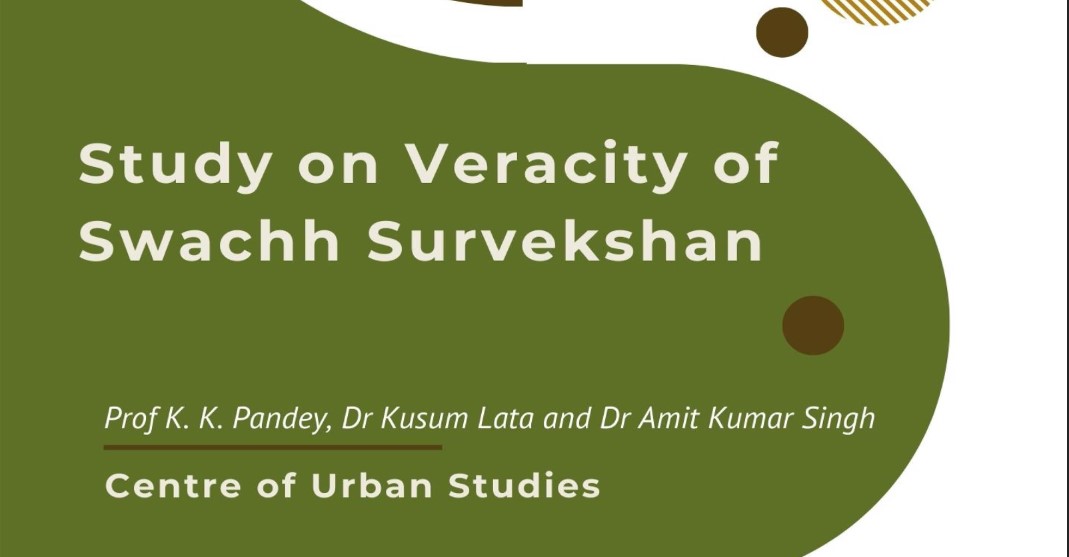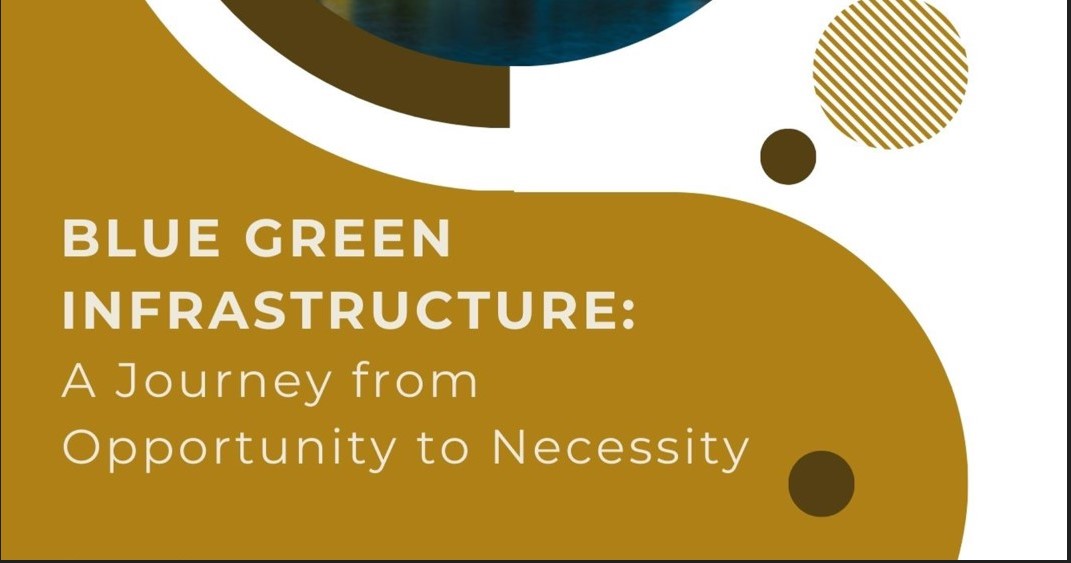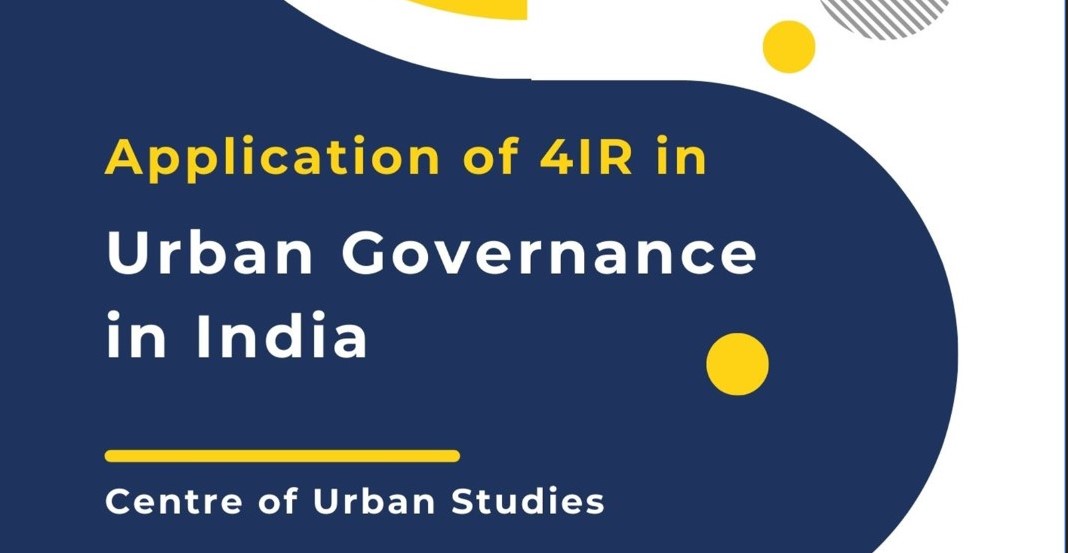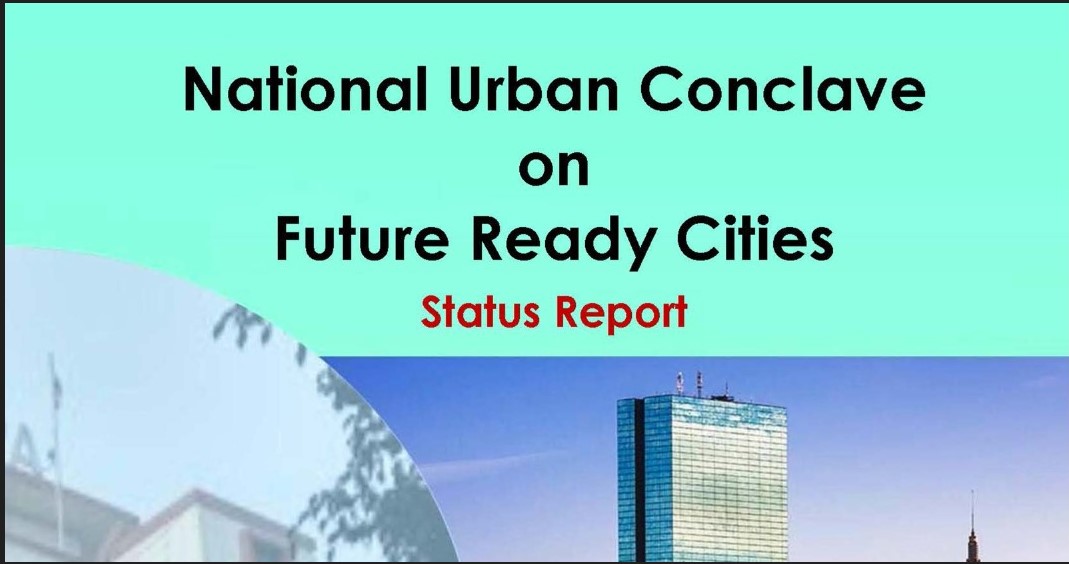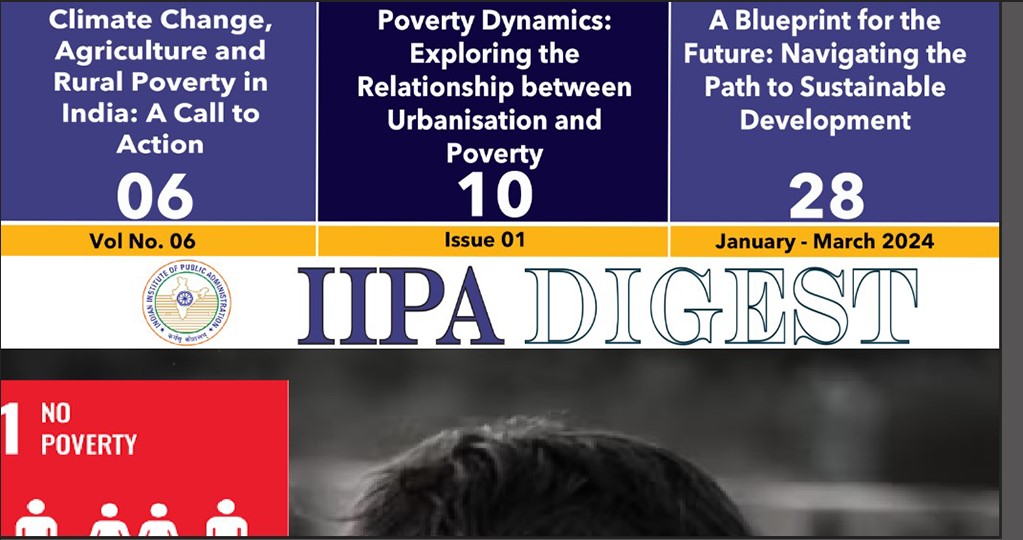Data for Development: Leveraging Tech and Evidence for Rural Policy
Abstract
A revolutionary strategy for creating inclusive and fact-based rural policy frameworks is Data for Development (D4D). Policymakers are now better able to plan, carry out, and oversee rural development projects by leveraging technology advancements and real-time data collection technologies. In order to improve accountability and transparency in infrastructure and welfare programs, this study examines the use of geospatial technologies, mobile-based surveys, and Management Information Systems (MIS) like e-MARG (electronic Maintenance of Rural Roads under PMGSY) and OMMAS (Online Management, Monitoring and Accounting System). Continuous outcome tracking is made possible by the integration of digital feedback mechanisms and real-time dashboards, which guarantees prompt remedial action and improved resource allocation. By bridging the gap between policy goals and actual conditions on the ground, these digital tools are also supporting impact evaluations at the granular level. The study focuses on effective case studies from Indian states where data-driven planning has enhanced rural health, education, water access, and road connection service delivery. But there are drawbacks to D4D deployment as well, such as infrastructural deficiencies, digital illiteracy, and data privacy issues. The study highlights the necessity of an ethical framework for data governance, robust institutional processes, and capacity-building initiatives. D4D provides a promising route to achieving sustainable and equitable development throughout India's extensive rural terrain by integrating technology and evidence at the centre of rural policy formulation.
Keywords: Data for Development, Rural Policy, Geospatial Data, MIS Platforms, Real-time Dashboards, Impact Evaluation
Introduction
Rural development is still essential to reducing poverty and promoting equitable growth, particularly in emerging nations like India, where around 65% of people live in rural regions (Census 2011). Data-driven policymaking is becoming increasingly important as governments and development organisations struggle to provide services to remote and frequently underserved populations. "Data for Development" (D4D) refers to the use of precise, timely, and actionable data to inform choices, distribute resources effectively, and guarantee accountability in developmental projects (Anupurba, Debnirmalya and Pushpa, 2009).1 It is not only about compiling statistics. The emergence of digital infrastructure, the proliferation of mobile connectivity, and the growing accessibility of administrative and geographical data have given policymakers previously unheard-of capabilities to comprehend rural realities, customise actions, and assess results. With an emphasis on the use of geospatial data, mobile surveys, Management Information Systems (MIS) like OMMAS and eMARG, real-time dashboards, result monitoring, and impact evaluation frameworks, this study examines how data is changing rural development policy. Similar to oil, data has become an essential resource in the twenty-first century, driving decisions in the areas of politics, the economy, health, and the environment. The strategic use of data, particularly big and open data, to inform policy, track progress, and expedite sustainable development is known as "Data for Development" (D4D). Leveraging data is now necessary for inclusive and equitable growth as nations work to achieve the Sustainable Development Goals (SDGs).
The Evolution and Importance of Data for Development
In the past, fragmentation, inadequate coverage, and antiquated methods have hampered data collection in developing nations. Data accessibility and utility have been completely transformed by the widespread use of digital technology, mobile phones, satellites, and internet connectivity. In order to plan, carry out, and assess development projects, governments, non-governmental organisations, academic institutions, and the commercial sector now depend more and more on data-driven insights (World Bank Report 2022).2 The 2030 Agenda for Sustainable Development by the UN acknowledges the value of data. In particular, Goal 17 (Partnerships for the Goals) asks for increasing capacity-building assistance to poor nations in order to expand the supply of timely, accurate, and high-quality data.3 Countries that successfully use data in policymaking can enhance development results by up to 20%, especially in the areas of economic planning, health, and education, according to the World Bank's 2023 report on data for development.4 Furthermore, more than 75% of development projects that used real-time data analytics had greater success rates and community satisfaction, according to an OECD report from 2022 (OECD Report 2023).5
Important Domains Where Development Is Driven by Data
Source: Medium
1. Economic Planning and Poverty Reduction
Finding patterns in poverty, creating focused interventions, and assessing the effects of policies are some of the most revolutionary uses of data. For example, in nations like Nigeria, Uganda, and India, poverty has been more precisely mapped using satellite images and mobile phone data than through conventional surveys. According to estimates from the World Bank's Poverty and Equity Global Practice, data-driven poverty mapping can boost social protection programmes' effectiveness by 25–30%. By cutting down on duplication and leakage, the Socio-Economic and Caste Census (SECC) data in India has improved the way welfare payments and subsidies are delivered (World Bank, 2025).6
2. Healthcare Delivery and Pandemic Response
Data was essential for monitoring the spread of the virus, controlling hospital capacity, and directing public health initiatives during the COVID-19 epidemic. Compared to the OECD average, South Korea's mortality rates were lowered by over 40% thanks to real-time data sharing between authorities and hospitals. Innovations in disease surveillance have also been fuelled by data. More than 100 countries use the Institute for Health Metrics and Evaluation's Global Burden of Disease (GBD) data to guide the distribution of health resources.
Remote populations in sub-Saharan Africa have been reached through the use of mobile health (mHealth) data. More than 450 million individuals in low- and middle-income nations utilise mobile health services, many of which rely on big data analytics for behaviour prediction and content personalisation, according to GSMA research from 2023.7
3. Education Planning and Learning Outcomes
Data systems are being used more and more to enhance the quality and accessibility of education. Countries using integrated education management information systems (EMIS) had 11% better learning outcomes and 14% higher school completion rates than those without, according to UNESCO's Global Education Monitoring Report (2023).8 In India, parents and decision-makers can access real-time school-level data using the UDISE+ system and the DIKSHA platform.9 In a similar vein, Kenya's National Education Management Information System has aided in identifying trends in dropout rates and providing support to students who are in danger.
4. Infrastructure and Urban Development
Data is essential to smart city water management, energy utilisation, and transportation planning. For example, public buses in Kigali, Rwanda, that have GPS installed offer real-time travel data, cutting typical commute times by 17%. To improve urban governance, the Smart Cities Mission in India gathers data via citizen apps and Internet of Things devices. In cities like Dar es Salaam and Kathmandu, OpenStreetMap, powered by volunteer data contributors, has assisted urban planners in designing infrastructure based on real population mobility patterns rather than antiquated maps (World Economic Forum, 2023).10
5. Agriculture and Food Security
In low-income nations, precision agriculture is revolutionising farming through the use of drones, satellite photography, and meteorological data. According to the Food and Agriculture Organisation (FAO), data-driven farming methods can lower resource consumption and boost crop yields by 10% to 30%. Digital platforms such as Esoko and ATA's Agricultural Transformation Agenda offer small farmers in Ghana and Ethiopia personalised guidance on weather alerts, crop prices, and planting schedules. According to an IFPRI report from 2022, this has increased farmer incomes by as much as 15%.
Data Source and Innovations
Data for Development comes from diverse sources:
• Administrative data (such as health records and census data)
• Survey data (such as Demographic and Health Surveys)
• Geographical data (e.g., satellite imagery)
• Big data (e.g., call detail records, social media analytics)
• Citizen-generated data (e.g., mobile apps, SMS surveys)
Fig 2: Different Types of Data (Source:)
Complex datasets may now be mined for insights with the aid of emerging technologies like AI and machine learning. For instance, the World Bank's AI algorithms can forecast infrastructure shortfalls by examining satellite photos of hospitals, schools, and roadways. By 2030, applying AI to development statistics might boost global GDP by $300–450 billion by improving fraud detection, service targeting, and operational efficiency, according to a McKinsey estimate from 2023 (Siddharth and Gill).11
The Challenge of Rural Development and the Potential of Data
A complex web of interconnected problems, including poverty, inadequate infrastructure, agrarian distress, gaps in health and education services, and climatic vulnerability, must be addressed by India's rural development programme. Real-time feedback, implementation difficulties, and local variance were frequently overlooked by traditional top-down policy approaches. Data becomes a game-changer at this point. Greater granularity, openness, and responsiveness in governance are made possible by the use of technology-enabled platforms for data collection, analysis, and dissemination. Policymakers can now prioritise funds, adjust plans, and track progress measures in real time thanks to the shift from paper-based, yearly surveys to dynamic digital platforms.
Case Study of Kanchan Ben Thakor of Gujarat: Kanchan Ben Thakor born in the northern Gujarati village of Chalwada in the Patan District, Kanchan comes from a family of seven. She remembers how, perhaps three years ago, one of her older sisters encouraged her to enrol in the government's tailoring skill-building program through DDU-GKY. A non-profit organisation at the nearby Rural Self Employment Training Institute (RSETI) led the skilling program. The Ministry of Rural Development has mandated that RSETI have dedicated infrastructure in every district of the nation in order to provide training and skill enhancement for the entrepreneurial development of rural youth in collaboration with the state governments, banks, and other developmental organisations. The 21-year-old currently owns her own sewing company where she stitches clothing, does changes, and embroiders. In the recent past, she has also trained three additional ladies.
Geospatial Data: Tracking Change and Mapping Needs
Remote sensing, GIS, and satellite imaging are examples of geospatial technologies that have completely changed how we think about and prepare for rural development. These tools make it possible to optimise resources, plan for specific locations, and track the development of infrastructure. When it comes to mapping needs and monitoring developments in rural development, geospatial data is revolutionary. It makes it possible to precisely monitor infrastructure, natural resources, and service delivery by combining satellite imagery, GIS platforms, and location-tagged data. Real-time mapping is supported in India via programmes like Bhuvan and the National Remote Sensing Centre (NRSC).12 For instance, the Jal Shakti Abhiyan identified nearly 96,000 water-stressed villages with the use of geospatial techniques (MDWS).13 Planners can use this data to prioritise investments, track changes in the environment, and guarantee fair access to resources based on socioeconomic and spatial realities.
A. Function in the Planning of Rural Infrastructure
The use of geospatial data has greatly benefited initiatives such as the Pradhan Mantri Gram Sadak Yojana (PMGSY).14 GIS is integrated into PMGSY's OMMAS (Online Management, Monitoring and Accounting System) to monitor rural road networks. Road construction is verified and quality control is ensured through the use of satellite images. To provide transparency and facilitate the building of future links, more than 8 lakh kilometres of rural roads have been geotagged using satellite data as of 2024. Through gap identification, resource allocation optimisation, and site selection guidance, geospatial data plays a crucial role in rural infrastructure development. It makes evidence-based choices for water systems, schools, highways, and health facilities possible, guaranteeing sustainability, affordability, and accessibility that is suited to regional demographic and geographic circumstances.
B. Application to the Management of Natural Resources
The Pradhan Mantri Krishi Sinchayee Yojana's Watershed Development Component (WDC-PMKSY) maps cropping patterns, water bodies, and land degradation using satellite images. This makes it possible to focus initiatives like soil conservation, reforestation, and check dams effectively.15 Efficiency and sustainability in the management of natural resources have greatly increased with the use of data and technology. Real-time monitoring of forests, water bodies, soil quality, and agricultural land is made possible by geospatial data, satellite imaging, and remote sensing. These tools enable data-driven conservation initiatives and assist policymakers in identifying illicit activities like over-extraction and deforestation. Localised analytics from mobile apps and dashboards help communities and farmers use resources sustainably. Planning watershed development, irrigation plans, and biodiversity conservation now requires integrated platforms like Bhuvan and the National Remote Sensing Centre (NRSC), which guarantee fair, well-informed, and ecologically responsible policy interventions.
C. Geographical Resources for Education and Health in Rural Areas
To find service shortages, users can overlay infrastructure, health, and education data on maps using initiatives like the Bhuvan platform from the National Remote Sensing Centre. For instance, geospatial analysis can direct future investments by identifying regions within a 5-kilometre radius that lack operational health sub-centres (Foster, Straub: 2023).16 In rural India, only 157,935 sub-centres, 24,935 PHCs, and 5,480 CHCs serve the 65% of the population (about 895 million) who live over 3.09 million km² (2021–22 data)17
There is a severe lack of specialists at CHCs, with 79.5% of positions open. In terms of education, rural literacy was 73.5% in 2018, whereas urban literacy was 87.7%. These differences draw attention to regional resource shortages in rural health and education.
Mobile Surveys: Reaching the Last Mile
Conventional surveys like the Census and the National Sample Survey (NSS) need a lot of resources and are conducted infrequently. Mobile surveys, which are frequently conducted through smartphones, IVRs, or SMS, provide quick and inexpensive ways to get primary data from far-flung locations. By efficiently reaching the last mile, mobile surveys are revolutionising the collecting of data in rural areas. With more than 500 million rural users and more than 1.2 billion mobile subscribers in India (TRAI, 2024), smartphone-based surveys provide a scalable and affordable way to collect input in real time. Even in remote areas, outreach is possible because more than 70% of rural families own a mobile phone, according to studies (PIB, 2918 May 2025). Inclusion is ensured by tools like SMS surveys and IVR (Interactive Voice Response), which record the voices of users with low literacy levels. Mobile surveys proved to be dependable in urgent and changing policy situations during the COVID-19 pandemic, as they were essential for tracking livelihoods, food security, and health.
A. Real-Time Data Collection
Near real-time data collection on household consumption, migration, health behaviour, or agricultural activities is made possible by mobile surveys. NGOs and academic institutes frequently use platforms like SurveyCTO, Kantar's mPower, and Gramvaani to gather longitudinal data from respondents in rural areas. NITI Aayog and research institutions employed mobile surveys to measure rural hardship and health service accessibility during the COVID-19 pandemic. One such initiative, IDinsight's COVID-19 Rural Impact Survey, addressed over 10,000 households through mobile devices and quickly revealed information about coping strategies and income shocks.
B. Gender and Inclusivity
In an effort to guarantee that women in rural homes are questioned directly, mobile platforms have also been modified to gather gender-sensitive data. For illiterate communities, mobile surveys have also improved data accessibility when paired with visual or audio aids. Although it still lags behind male literacy at 87.2%, India's female literacy rate increased from 65.5% in 2011 to 74.6% (age 7+, PLFS 2023-24).19 The percentage of women in the work force increased from 23.3% in 2017–18 to 41.7% in 2023–24. Women made up 45.0% of MGNREGA members in rural Uttar Pradesh in early 2025, compared to 35% in 2018–19. However, only 15% of rural women have an internet connection, compared to 30% of rural men, underscoring the ongoing isolation from the digital world.
C. Challenges and Moral Aspects
However, sample bias, privacy issues, and non-response from places with inadequate connectivity are problems for mobile surveys. Strict adherence to ethical norms in data protection, anonymisation, and consent is required. Data gaps, digital exclusion, and ethical issues are major obstacles to rural development. Despite the high rate of cell penetration, gendered data disparities exist because only 25% of rural women have internet access (NFHS-5). Given that only 38% of Indians are aware of their digital rights, informed consent, privacy, and data misuse continue to be moral dilemmas (IAMAI, 2023). Transparency, fair access, and culturally aware methods are necessary for the ethical use of data in order to prevent marginalisation and guarantee confidence in data-driven rural governance.
MIS Platforms: The Foundation for Execution
Digital platforms called Management Information Systems (MIS) are made to track and oversee the real-time execution of government programs. These systems play a key role in operational decision-making by integrating administrative, financial, and physical progress data. Platforms for management information systems (MIS), which provide efficiency and transparency, serve as the cornerstone for carrying out rural infrastructure projects. For example, from project conception to completion, road proposals, allocations, and payments are digitally tracked by PMGSY's Online Management, Monitoring and Accounting System (OMMAS). Nationwide, MIS dashboards geo-tag and update more than 90% of items related to rural road development and maintenance. With e-MARG installed throughout 1,330 PIUs in 30 states, maintenance is controlled, and over 346,000 km of rural roads are monitored during defect-liability times. These systems improve accountability in rural governance, guarantee real-time tracking, expedite processes, and reduce delays.
A. OMMAS (Online Management, Monitoring and Accounting System)
OMMAS, which was created for PMGSY, has revolutionised rural road construction management by monitoring the financial and physical progress of each project. Features consist of:
• Road mapping using GIS
• Photographic documentation of the building phases
• Online contractor and tender tracking
• Progress-linked tracking of fund disbursements
According to a Ministry of Rural Development assessment conducted in 2023, OMMAS has improved cash flow transparency and helped to reduce project delays by 30%.
B. eMARG (Electronic Maintenance of Rural Roads under PMGSY)
A NIC-developed enterprise e-governance platform called eMARG (Electronic Maintenance of Rural Roads under PMGSY) is utilised in 1,330 PIUs in 30 states to manage performance guarantees and defect responsibility for five years. It facilitates enhanced road quality monitoring, transparent billing, AI/ML analytics, and geo-tagged inspections. eMARG, which was first introduced in 2018, makes it easier to oversee completed roads' maintenance under PMGSY. The platform permits:
• Data entry on road conditions using mobile applications
• Automatic creation of maintenance agreements
• Modules for performance-based payments
As of 2024, more than 1.2 lakh roads have been digitalised under eMARG, contributing to increased road accountability and sustainability.
C. Additional Platforms for Rural MIS
• RubanSoft: Under the Shyama Prasad Mukherji Rurban Mission, RurbanSoft monitors the growth of rural clusters.
• AwaasSoft: Using geotagged pictures, AwaasSoft manages home data under PMAY-G, including the status of house development.
• JanMANREGA: Under MGNREGA, it keeps track of work card issuance, wage payments, and attendance in real time.
Real-Time Dashboards: Openness and Prompt Response
Dashboards present MIS data in a way that residents, field officers, and decision-makers can easily understand. Using real-time dashboards facilitates performance benchmarking and guarantees prompt response to bottlenecks. By increasing responsiveness, openness, and transparency in rural development, real-time dashboards have completely changed governance. These online resources offer current visual depictions of service delivery metrics, resource usage, and programme performance. Administrators and policymakers can identify bottlenecks, identify underperforming areas, and take immediate corrective action by using real-time dashboards that integrate data from several sources, including MIS systems (e.g., OMMAS, eMARG). At every level of governance, this promotes an accountable culture and data-driven decision-making. Furthermore, the availability of these dashboards to the general public encourages participatory governance by enabling citizens, journalists, and civil society organisations to track the development of programmes. Furthermore, the availability of these dashboards to the general public encourages participatory governance by enabling citizens, journalists, and civil society organisations to track the development of programs. These dashboards have been crucial in guaranteeing prompt and focused interventions during emergencies, including pandemics or natural catastrophes. In the future, improving real-time dashboards' precision, compatibility, and usability will be essential to implementing more flexible and inclusive rural development plans nationwide.
A. Data-Driven Governance through Dashboards
Users can view PMGSY, MGNREGA, NRLM, and PMAY-G performance data on the Ministry of Rural Development's Rural Development Dashboards. Fund utilisation, completion rates, and beneficiary coverage can be used to compare states and districts. NITI Aayog created the ASPIRE Dashboard, which monitors aspirational district metrics in the areas of infrastructure, agriculture, education, and health. These dashboards are used by district collectors to pinpoint regions that are falling behind during monthly reviews.
B. Mixed-Method Impact Evaluations
Mixed-method impact evaluations evaluate the efficacy of policies or programmes by combining quantitative and qualitative methods. Through the capture of statistical trends and more profound contextual insights, this approach improves reliability. It provides a comprehensive perspective necessary for well-informed decision-making in intricate rural development or social policy situations, helping to comprehend not just what works but also how and why it works. In order to perform thorough effect evaluations of rural initiatives, researchers are now combining administrative data, mobile surveys, and randomised controlled trials (RCTs). For example:
• J-PAL conducted an RCT in Odisha that improved immunisation by combining MIS data with cell phone reminders.
• The Development Data Lab evaluated PMAY-G in 2021 by measuring post-construction improvements in dwelling quality using satellite data.
C. Citizen Feedback and Participatory Tracking
Participatory tracking and citizen input are essential elements of responsible rural governance. Governments may guarantee openness, responsiveness, and inclusivity by directly integrating communities in the monitoring of infrastructure and services. Through mobile apps, citizens can submit problems with road quality through platforms like Meri Sadak under PMGSY, which guarantees quicker grievance resolution. More than 1.2 lakh complaints were filed in 2023, and more than 85% of them were resolved. Community scorecards, social audits, and local feedback systems that give voice to under-represented groups are more examples of participatory techniques. By ensuring that rural development initiatives are in line with local requirements, this bottom-up monitoring enhances service delivery, builds trust, and gives recipients a sense of accountability and ownership. Road issues can be reported by citizens using crowdsourced platforms such as Mera PMGSY Road. Community involvement is used in MGNREGA social audits to confirm data and guarantee integrity.
Case Study: The Transformation of Rural Roads in Bihar
The Pradhan Mantri Gramme Sadak Yojana (PMGSY) has significantly improved rural connectivity in Bihar. More than 20,000 communities benefited from the construction or improvement of more than 58,000 km of rural roads in the state between 2014 and 2024. Better transparency in project execution and real-time monitoring were made possible by the deployment of the eMARG platform. Road connectivity in rural Bihar increased from 46% in 2011 to over 87% in 2023, per a 2023 report from the Ministry of Rural Development. This change greatly improved access to markets, healthcare, and educational institutions. According to Asian Development Bank research, connected villages saw a 17% increase in school attendance and a 22% increase in agricultural income. The change demonstrates how inclusive rural infrastructure development in underdeveloped areas like Bihar can be fuelled by data-driven monitoring, local involvement, and robust institutional frameworks. One example of how integrated data systems might change results is the Bihar Rural Roads Program. The state used OMMAS, GIS mapping, e-tendering, mobile inspection apps, and drone-based monitoring as part of the PMGSY and Bihar State Road Project.
From 2015 to 2023:
• Compliance with road quality increased from 72% to 93%.
• 22% less time was spent on construction.
• The backlog of maintenance was reduced by 35%.
Both proactive policy modification and effective execution were facilitated by this data-enabled ecosystem.
Policy Recommendations and Way Ahead
Strengthening data infrastructure, guaranteeing MIS platform compatibility, encouraging digital literacy in rural areas, and protecting data privacy should be the main goals of policy suggestions. Investing in capacity building and promoting public-private partnerships will increase efficacy. To promote inclusive, open, and flexible rural development outcomes throughout India, it is imperative to cultivate a culture of evidence-based policymaking. The following tactics are essential for expanding the use of data for rural development:
1. Capacity Building
Many employees at the district and block levels are not data literate. Data ethics, dashboard interpretation, and data-collecting procedures must be emphasised in training sessions.
2. Data Interoperability
MIS systems frequently function in isolation. Integrated rural planning will be made possible by smooth data interchange between PMAY, MGNREGA, NRLM, and databases related to health or education.
3. Privacy and Data Protection
Strong data protection regulations in line with India's Digital Personal Data Protection Act (DPDPA), 2023, are required due to the growing usage of location and personal data.
4. Promoting Public-Private Collaborations
Innovation in rural data systems can be introduced through collaborations with startups, IT companies, and academic institutions. Wadhwani AI, for instance, has increased crop production in Maharashtra by using AI to predict pests.
5. Platforms Focused on Citizens
Mobile applications, WhatsApp bots, or IVR lines should be used to improve the tools for public feedback, grievance redress, and participatory planning.
Conclusion
Using data and technology for rural development is now essential rather than optional in the age of fast digital transformation. Mobile-based surveys, big data, geospatial analytics, and Management Information Systems (MIS) platforms like OMMAS and eMARG have all come together to change the way rural policies are planned, carried out, and tracked in India. Policymakers may now make well-informed, evidence-based decisions that adapt dynamically to ground realities thanks to real-time dashboards and outcome-tracking tools. In addition to increasing accountability and transparency in program delivery, the strategic use of data enables interventions to be customised to the various requirements of rural populations. From tracking the status of road building to tracking health indicators and the results of the Mahatma Gandhi National Rural Employment Guarantee Act (MGNREGA), digital platforms make sure that resources are used as efficiently as possible and that effects are assessed. Additionally, by providing rural communities with a say in determining the policies that impact their lives, citizen-centric feedback loops and mobile surveys are empowering them. The nexus of evidence, empathy, and creativity is where rural development is headed. Data becomes more than simply a tool as India strives for a $5 trillion economy with inclusive growth. Technology is changing how rural policy is conceived, carried out, and assessed, from satellites that can view every village road to smartphone apps that provide a voice to the impoverished in rural areas. Although data for development is not a panacea, it may guarantee that no community, home, or person is left behind if it is used sensitively and strategically. In order to create a future where rural India is not only counted but also fully accounted for, the task at hand is to integrate this data revolution into all tiers of rural governance. Data is now an enabler of transformation rather than only a development input. It has the capacity to eliminate disparities, strengthen communities, and maximise resources when applied sensibly and inclusively. Data for development is a viable route to accomplishing the SDGs and creating a resilient, just future, from mapping poverty to combating pandemics and improving education. Making sure that data works for everyone leaving no one behind rather than data scarcity, is the true challenge as digital infrastructure expands and AI capabilities advance.
The focus on data-driven governance in rural regions will be crucial as India works to meet the Sustainable Development Goals (SDGs). But there are difficulties along the way. Digital literacy, platform interoperability, data quality, and privacy protections continue to be major issues. It will be crucial to address issues through public-private partnerships, capacity-building, and robust institutional frameworks. Lastly, inclusive and sustainable development may be unlocked by incorporating evidence and technology into rural policy frameworks. The key to the future is developing flexible governance models that fully utilise data, not just as a monitoring tool but also as a driving force behind innovation, equity, and revolutionary transformation in rural India.
Reference
1. Debnirmalya Gangopadhyay, Apurba Kumar Mukhopadhyay and Pushpa Singh, SSRN (September 2009).
2. Word Bank Report, 2022, URL: https://documents1.worldbank.org/curated/en/099230004062228270/pdf/P1723000e5e0d20908c790a5ffdda147f1.pdf
3. United Nations, Department of Economic and Social Affairs, Sustainable Development, (2030 Agenda), URL: https://sdgs.un.org/2030agenda
4. World Bank Development Report 2024, URL: https://www.worldbank.org/en/publication/wdr2024
5. Development Co-operation Report 2023: Debating the Aid System, OECD Report 2023, URL: https://www.oecd.org/en/publications/development-co-operation-report-2023_f6edc3c2-en/full-report.html
6. Global Poverty Update from the World Bank, URL: https://blogs.worldbank.org/en/opendata/june-2025-global-poverty-update-from-the-world-bank--2021-ppps-a
7. The Global Burden of Disease (2021), URL: https://www.healthdata.org/sites/default/files/2024-05/GBD_2021_Booklet_FINAL_2024.05.16.pdf
8. UNESCO’s Global Education Monitoring Report (2023), URL: https://www.unesco.org/gem-report/en
9. Ibid.
10. The World Economic Forum (2023), Smart Cities: Promoting Urban Governance in India, URL: https://www.weforum.org/publications/smart-cities-promoting-urban-governance-in-india/
11. Siddharth Dixit and Indermit S Gill, AI, the new Wingman in Development, World Bank, URL: https://thedocs.worldbank.org/en/doc/20ca38de6ebb3fc55a9c6a2883bffda8-0050022024/original/AI-the-new-wingman-of-development-Siddharth-Dixit-and-Indermit-Gill.pdf
12. National Remote Sensing Centre (NRSC), URL: https://www.nrsc.gov.in/
13. Ministry of Drinking Water and Sanitation, GoI, URL: https://bhuvan-app1.nrsc.gov.in/gwis/
14. Pradhan Mantri Gram Sadak Yojna (PMGSY), URL: https://www.omms.nic.in/
15. Water Development Component-Pradhan Mantri Krishi Sinchayee Yojana 2.0 MIS, Department of Land Resources, Ministry of Rural Development, GoI, URL: https://wdcpmksy.dolr.gov.in/
16. The Impact of Infrastructure on Development Outcomes, Policy Research Working Paper, 2023, URL:
https://documents1.worldbank.org/curated/en/099529203062342252/pdf/IDU0e42ae32f0048304f74086d102b6d7a900223.pdf
17. Question no. 839 asked in Lok Sabha and answered in 26 July 2024, URL: https://sansad.in/getFile/loksabhaquestions/annex/182/AU839_tP39Zb.pdf?source=pqals
18. Press Information Bureau (PIB), Result of Comprehensive Modular Survey: Telecom, 2025, (January-March 2025), URL: https://www.pib.gov.in/PressReleasePage.aspx?PRID=2132330
19. Annual Report of Periodic Labour Force Survey (PLFS) Report (2023 July-2024 June), GoI, Ministry of Statistics and Programme Implementation, National Sample Survey (NSS) Office, URL:
https://dge.gov.in/dge/sites/default/files/2024-10/Annual_Report_Periodic_Labour_Force_Survey_23_24.pdf
20. Aggarwal, N. & Prasad, R. (2021), “Leveraging Mobile-Based Surveys to Improve Policy Design in Rural India”, Journal of Development Policy and Practice, 6(2), pp. 123-145.
21. Annual Report of Periodic Labour Force Survey (PLFS) Report (2023 July-2024 June), GoI, Ministry of Statistics and Programme Implementation, National Sample Survey (NSS) Office, URL:
https://dge.gov.in/dge/sites/default/files/2024-10/Annual_Report_Periodic_Labour_Force_Survey_23_24.pdf
22. Banerjee, A. & Duflo, E. (2019), Good Economics for Hard Times: Better Answers to Our Biggest Problems. Penguin Books. (Chapter on "Data, Evidence and Development Economics”).
23. Bhattacharya, S. & Mishra, P. (2023), “The Promise and Pitfalls of Real-Time Dashboards in Indian Rural Governance”, South Asia Economic Journal, 24(1), pp. 1–20.
24. Chattopadhyay, R. (2022), “Open Data and Transparency in Indian Rural Policies”, Journal of Governance and Public Policy, 12(1), pp. 45–64.
25. Debnirmalya Gangopadhyay, Apurba Kumar Mukhopadhyay and Pushpa Singh (September 2009), Rural Development: A Strategy for Poverty Alleviation in India, India Science and Technology (online) 2008, Social Science Research Network (SSRN), URL: https://papers.ssrn.com/sol3/papers.cfm?abstract_id=1473041
26. Desai, R.M., Vanneman, R., & Dubey, A. (2015), "India Human Development Survey: Tracking Changes in Rural Development Indicators", India Policy Forum, Vol. 11, pp. 1–35.
27. Development Co-operation Report 2023: Debating the Aid System, OECD Report 2023, URL: https://www.oecd.org/en/publications/development-co-operation-report-2023_f6edc3c2-en/full-report.html
28. Digital India Corporation (2022), ICT Interventions in Rural Development: Status and Impact, Ministry of Electronics and IT.
29. Ghosh, A. (2022), "Using Mobile Technology for Rural Development Surveys: Lessons from Bihar", Social Change, 52(2), pp. 167–185.
30. Global Poverty Update from the World Bank, URL: https://blogs.worldbank.org/en/opendata/june-2025-global-poverty-update-from-the-world-bank--2021-ppps-a
31. Government of India (2023), eMARG Portal, Online Management, Monitoring and Accounting System. Ministry of Rural Development. URL: https://emarg.gov.in
32. Government of India (2022), Online Management, Monitoring and Accounting System (OMMAS), Ministry of Rural Development, URL: https://omms.nic.in
33. Indian Council for Research on International Economic Relations (ICRIER) (2022), Harnessing Data for Rural Growth, ICRIER Policy Brief.
34. India Rural Development Report (IRDR) (2022), Rural Transformation through Data and Innovation. IDFC Institute, New Delhi.
35. Indian Space Research Organisation (ISRO) (2022), Applications in Rural Development, URL: https://bhuvan.nrsc.gov.in
36. International Telecommunication Union (ITU) (2021), Digital Development in Rural Areas: Global Trends and Case Studies, Geneva: ITU Publications.
37. Jain, S. & Singh, P. (2020), “Big Data and Evidence-Based Policy in Indian Agriculture”, Current Science, Vol. 118(10), pp. 1545–1551.
38. Kapur, D., & Mukhopadhyay, P. (2019), Navigating Data for Development in India, Centre for Policy Research Working Paper.
39. Mehta, S. & Sharma, A. (2022), “Using Geospatial Data for Better Governance in Rural India”, Economic & Political Weekly, Vol. 57, Issue 44, pp. 27-32.
40. Ministry of Drinking Water and Sanitation, GoI, URL: https://bhuvan-app1.nrsc.gov.in/gwis/
41. Ministry of Electronics and Information Technology (MeitY) (2023), India Stack and Rural Digital Ecosystems, Government of India.
42. Ministry of Panchayati Raj (2022), GIS-Based Planning Tools for Gram Panchayats, Government of India.
43. National Informatics Centre (NIC) (2021), Integration of MIS and Real-Time Monitoring Tools in Rural Schemes, Government of India.
44. National Remote Sensing Centre (NRSC), URL: https://www.nrsc.gov.in/
45. National Sample Survey Office (NSSO) (2021), Household Social Consumption and ICT in India, Ministry of Statistics and Programme Implementation.
46. NITI Aayog (2021), Harnessing Artificial Intelligence for Inclusive Growth, Discussion Paper, New Delhi.
47. NITI Aayog (2020), Strategy for New India @ 75, URL: https://niti.gov.in/strategy-new-india-75
48. Organisation for Economic Co-operation and Development (OECD) Report 2023: Development Co-operation Report 2023: Debating the Aid System, URL: https://www.oecd.org/en/publications/development-co-operation-report-2023_f6edc3c2-en/full-report.html
49. Organisation for Economic Co-operation and Development (OECD) (2020), Data for Development: A Framework for Action. OECD Publishing, URL: https://www.oecd.org
50. Press Information Bureau (PIB), Result of Comprehensive Modular Survey: Telecom, 2025, (January-March 2025), URL: https://www.pib.gov.in/PressReleasePage.aspx?PRID=2132330
51. Pradhan Mantri Gram Sadak Yojna (PMGSY), URL: https://www.omms.nic.in/
52. Radhakrishnan, M. (2023), “Digital Public Goods and Rural Data Platforms in India”, Indian Journal of Public Administration, 69(3), pp. 278–296.
53. Question no. 839 asked in Lok Sabha and answered in 26 July 2024, URL: https://sansad.in/getFile/loksabhaquestions/annex/182/AU839_tP39Zb.pdf?source=pqals
54. Rajadhyaksha, M. (2021), "Why Data-Driven Governance Matters for Indian Villages." Livemint, March 2021, URL: https://www.livemint.com
55. Siddharth Dixit and Indermit S Gill, AI, the new Wingman in Development, World Bank, URL:
https://thedocs.worldbank.org/en/doc/20ca38de6ebb3fc55a9c6a2883bffda8-0050022024/original/AI-the-new-wingman-of-development-Siddharth-Dixit-and-Indermit-Gill.pdf
56. Singh, A. (2020), “Real-Time Policy Feedback through Data Dashboards: Case of PMGSY Roads”, Yojana, October 2020, pp. 18–21.
57. The Global Burden of Disease (2021), URL: https://www.healthdata.org/sites/default/files/2024-05/GBD_2021_Booklet_FINAL_2024.05.16.pdf
58. The Impact of Infrastructure on Development Outcomes, Policy Research Working Paper, 2023, URL:
https://documents1.worldbank.org/curated/en/099529203062342252/pdf/IDU0e42ae32f0048304f74086d102b6d7a900223.pdf
59. United Nations (2020), Principles on Data for Sustainable Development. UN Statistics Division, URL: https://unstats.un.org
60. Water Development Component-Pradhan Mantri Krishi Sinchayee Yojana 2.0 MIS, Department of Land Resources, Ministry of Rural Development, GoI, URL: https://wdcpmksy.dolr.gov.in/
61. World Bank (2021), Data for Better Lives: World Development Report 2021. Washington D.C.: World Bank Group. URL: https://wdr2021.worldbank.org
62. World Bank Development Report (2024), URL: https://www.worldbank.org/en/publication/wdr2024
63. World Bank Report (2022), South Asia’s Digital Economy: An Opportunity to Build Back Better Digitally, URL:
https://documents1.worldbank.org/curated/en/099230004062228270/pdf/P1723000e5e0d20908c790a5ffdda147f1.pdf
64. The World Economic Forum (2023), Data for Development: Global Frameworks and National Use Cases, URL: https://www.weforum.org
65. The World Economic Forum (2023), Smart Cities: Promoting Urban Governance in India, URL: https://www.weforum.org/publications/smart-cities-promoting-urban-governance-in-india/
66. UNESCO’s Global Education Monitoring Report (2023), URL: https://www.unesco.org/gem-report/en
67. United Nations, Department of Economic and Social Affairs, Sustainable Development (2030 Agenda), URL: https://sdgs.un.org/2030agenda
68. United Nations Development Programme (UNDP), India (2021), Impact Evaluation and Data-Driven Governance in Rural India, URL: https://www.undp.org/india
Leave a comment
More articles from Urban & Rural Areas
